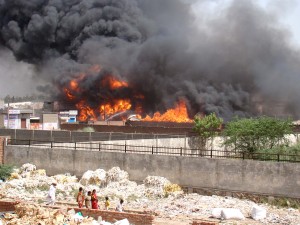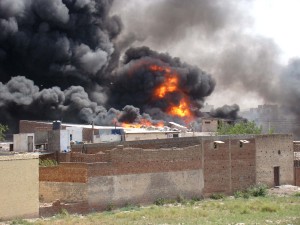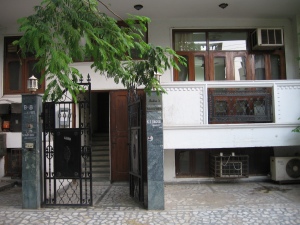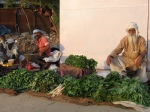Water for many is the biggest problem in Savda Ghevra. Although many think the water situation isn’t as bad as they had experienced in their previous slums. There are wells with hand pumps spread out around the colony but the water is hard and not potable. Drinking water is delivered by water truck on a daily basis. The delivery times are not regular and people queue for a long time with jerry cans and buckets. I talked with some people and they seemed to think that people fight less over the water these days as the community has made some ‘rules’ for lining up in 2 lines and waiting in turn however this didn’t appear to b e the case when i saw the water truck arrive. It was a free-for-all. Some ladies are unable to maintain a fixed job as they need to get the water and as a result a communal weaving livelihood programme has been halted. Many men are out at work (apparently 50% are employed) so can’t help with the water – it leaves the young children to help out. And they should be in school.
Savda Ghevra
•July 12, 2009 • Leave a CommentI made my first field visit to Savda Ghevra and one of the local NGOs called CURE had set up an informal chat with a dozen youth. The photos below are taken from outside their small house come office in which 12 of us squeezed onto the floor. They were all expecting wonderful advice from me on Disaster Management – not quite sure who they thought I was but we had a great 1.5hr chat and discussion on youth leadership and the (disaster) risks of living in Savda. The well provides water for washing clothes and washing but is not suitable for drinking. The drains were blocked with rubbish and the stagnant water was frightening pink hue. Electricity is available for every house and even the bamboo and mat shacks have a meter.
Interviews with youth organisation leaders
•July 12, 2009 • Leave a CommentI was invited to the NW Delhi Disaster Management Authority office to meet with 2 youth leaders. Both had previously been recognised for their youth work and awarded ‘youth of the year’. They are no longer considered ‘youth’ although many statistics count those under 40 as youth. I’m alright for another few years then! The interviews lasted for 2 hours with wonderful interpretation from Sulakshana. We stopped for a chai and samosa break and continued until lunch. The two office staff shared their lunch with me as I hadn’t bought anything with me. I really didn’t think I’d still be there at lunch time!
One of the risks of living in a slum
•July 12, 2009 • Leave a CommentOne of the biggest risks in the slums of Delhi is fire. These pictures are from Mr. Rai who I interviewed yesterday. A rubber factory had gone up in flames and he called the fire brigade. Apparently no-one was killed but I think many would have lost their homes located nearby.


Slum demolition – eviction that leads to resettlement for some
•July 2, 2009 • Comments Off on Slum demolition – eviction that leads to resettlement for someSavda Ghevra is currently home to about 7,000 families. These families have been evicted from previous ‘unauthorised’ slums which developed over the years. One lady’s grandma had lived there for 45years – this is how they were moved (see video):
This 7min video shows the destruction of one of the slums in Delhi. A community developed over decades knocked to the ground in days. Some of these people have been ‘resettled’ to Savda Ghevra.
My research site
•July 1, 2009 • Leave a CommentI have decided to conduct my research in a ‘Resettlement Colony’ called Savda Ghevra. This is one of a number of resettlement colonies in Delhi and the first families were relocated here 3 years ago. It is on the outskirts of Delhi and far away from where most families had been living prior to their eviction. More will follow about Savda Ghevra shortly.
My journey to work… well the office… i don’t have my research site yet!
•June 30, 2009 • Leave a CommentI take the bus to the office in the morning. The bus stop is a ten minute walk over a river-come open sewer which attacks all your senses as you’re still trying to adjust to the searing morning heat. I just hope that the wind is blowing away from the road to take the smells elsewhere.
It’s a fight to get on the bus in the morning as everyone jostles and elbows their way on. The first morning I let everyone go first but barely managed to jump and hang on as the bus pulled away. I now join the melee and have got used to the running jump when the bus barely comes to a halt. It’s 5rupees (10p) for the 20min journey to the office.
The bus pulls over to spit the people out and I cross the road between the motorbikes and autorickshaws. I cross over a small rubbish dump and a market where men are selling vegetables everyday.
Mock Emergency Drill
•June 28, 2009 • Leave a CommentI was invited by the National Disaster Management Authority to one of four Mock Emergency Drills being held today in Delhi. The drill simulated a terrorist attack with 4 terrorists entering the station, holding commuters hostage and taking control of the Control Room. People are particularly concerned about a repeat of the Mumbai attacks, especially with the Commonwealth Games due to be hosted here in 2010.
Just before the Mock Drill started (at 8a.m.) all commuters were evacuated and sniffer dogs were employed to check for any bombs. Civil Defence volunteers then entered the station and played dead or injured as a fake bomb was detonated to simulate a terrorist attack. Different agencies entered the station as and when they could respond to the emergency call.
It was certainly interesting to watch it all unfold. There seemed to be a lack of coordination between the different agencies involved – the Fire, Police, Ambulance services, Metro Security and Army. But I guess this is why we have Mock Drills to learn and improve. There were a lot of big guns, official uniforms and shouting and screaming – oh and sweat – I think the A/C was turned off!
Some feedback from the reports submitted to the Chief Minister included: Needing to block tunnel exits to prevent terrorists escaping; and the wounded should be treated and held close by as key eye-witnesses.
ps if anyone knows how to upload photos so they stay the right way up then please let me know!
Staying in Delhi
•June 26, 2009 • Leave a CommentSo things haven’t exactly gone to plan. I came out under the auspices of Save the Children UK who had put me in touch with Save the Children India (StCI) who in turn had put me in touch with SEEDS India. Together they were going to help facilitate my research here. So it turns out that StCI are not really able to host me in any form. SEEDS have since gone out of their way to host me. This means that I have cancelled my planned trip to Patna, Bihar and decided to stay here in Delhi where it will be easier to make contacts and access other resources. SEEDS have put me up in their staff guesthouse and I have some desk space at their office. We’ll see what happens!
The week has been a bit of a rollercoaster but I have made some contacts and had some meetings with the Indian National Disaster Management Authority and UNDP staff. I’m hoping I can gain access to a slum with an interpreter to help me conduct my interviews and research. If only I had known before I would have done this groundwork before coming to India. Oh well, just another challenge!
I’m putting up (staying in local talk) in a nice upmarket residential area – the staff call the flat it B-8. I soon realised however that no bus drivers or autorickshaw drivers knew where B-8 was! Fortunately I remembered the way i had come and found my way home the first night.
Why am I here?
•June 25, 2009 • Leave a CommentSo why am I here in India? This is the final part of my Masters programme at King’s College, London. I’m here to conduct research for my final dissertation due in 2 months time. I’m reading an MA in Disasters, Adaptation and Development.
The topic of my research is Youth Leadership in an Urban Slum and the implications for Disaster Risk Reduction. I intend to interview youth aged 16-25 who are living in an urban slum prone to disasters. Disasters could be anything from earthquakes to floods, fire or other environmental hazards that cause disasters. Reducing the disaster risk could involve measures to clear rubbish or unblock drains or implement early warning systems or awareness campaigns – essentially reducing people’s vulnerability to disaster events.































